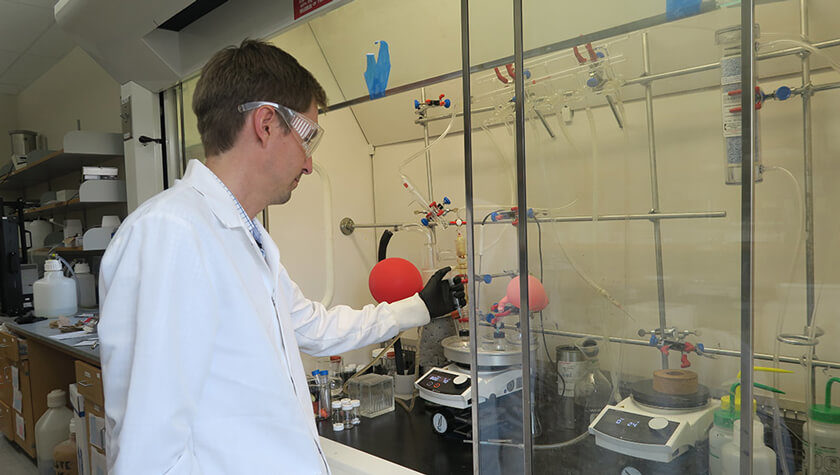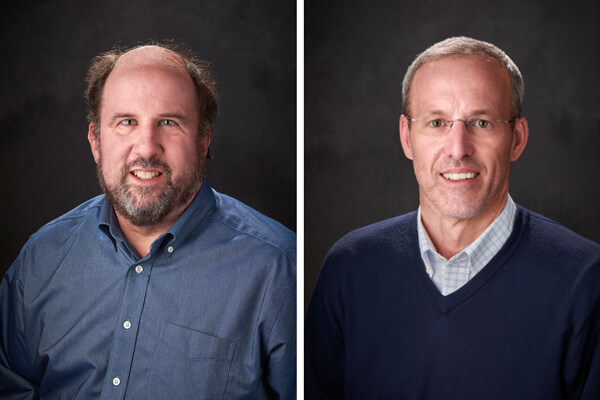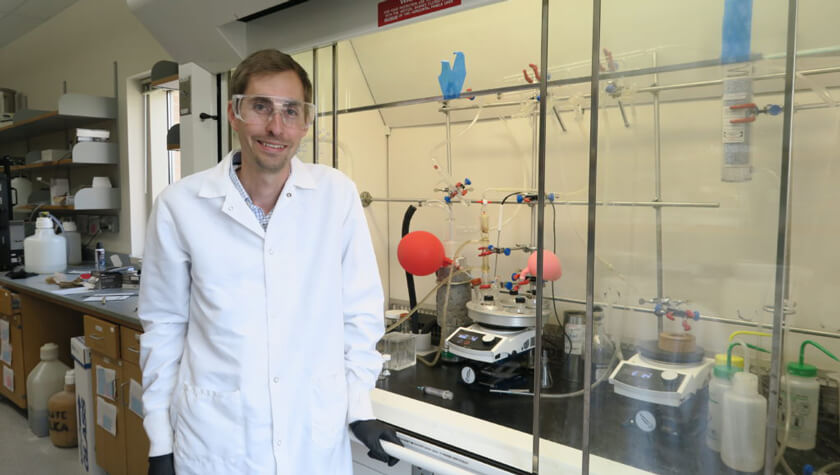
7
June

The first in a three-part series exploring how School of Pharmacy faculty are curbing the opioid epidemic
By Katie Gerhards
There are nearly as many Wisconsin citizens misusing opioids as there are people living in the state’s capital city of Madison.
According to the Healthy Wisconsin initiative, there were nearly 200,000 people illegally using prescription opioids in 2016 — and that’s without considering the thousands more using drugs like heroin. Although the numbers of opioid-related hospital stays and emergency room visits have declined nationally since 2016, overdose deaths surged to an all-time high in 2017, to 70,200. Fentanyl accounted for more than 40 percent of those fatal opioid overdoses.
“There’s some indication that we’re turning a corner,” says Cody Wenthur, assistant professor in the University of Wisconsin–Madison School of Pharmacy’s Pharmacy Practice Division, whose research lab is exploring a vaccine approach to treating opioid use disorder. “A big driver of that decrease in hospital visits been a transition away from prescription opioid abuse, which dominated for the first 15 years of the opioid misuse epidemic.”
In Wisconsin, the number of prescription opioids dispensed dropped by nearly 30 percent between 2015 and 2018. Because the rate of opioids being prescribed in Wisconsin is dropping, many researchers are now focusing on how to help the individuals who are already dependent on the substance.
In this article, the first in a three-part series, we’ll take a closer look at faculty and researchers who are on the side of the spectrum devoted to treating opioid use disorder by exploring new ways to leverage pharmacists and working toward a vaccine to help extinguish addiction.
Pharmacist role in treatment
“It’s a matter of access,” says Jay Ford, assistant professor in the School’s Social and Administrative Sciences (SAS) Division. “If you go to smaller rural communities in Northern Wisconsin, there might not be a physician within an hour’s drive — but there will be a pharmacist.”
Ford has spent 15 years working in behavioral health, addressing alcohol and opioid use disorders. But before joining the School’s faculty in 2018, his research hadn’t involved pharmacists.
“Pharmacists have been kind of marginalized in the efforts to address this epidemic. But they are trained and legally empowered to play a more active role.” –Jay Ford
“Pharmacists have been kind of marginalized in the efforts to address this epidemic,” says Ford. “But they are trained and legally empowered to play a more active role.”
In a new study published in the Research in Social and Administrative Pharmacy journal, Assistant Professor Kevin Look, in the School’s Social and Administrative Sciences (SAS) Division, found that community pharmacies are ideally located in rural areas that lack formal substance abuse treatment facilities.
His analysis showed that all but one of Wisconsin’s 14 rural counties without a formal treatment facility had at least one community pharmacy. These pharmacies, as the most accessible source of health care in those areas, are essential inroads to providing substance abuse care, especially as the rates of opioid misuse in rural areas are nearly on par with urbanized areas.
Ford and William S. Apple Distinguished Chair David Mott, professor and chair of the SAS Division, have launched dual projects to help pharmacists around the state practice at the top of their license to serve Wisconsin citizens struggling with opioid use disorder.

The Area Health Education Council (AHEC), a community-based organization that works to improve access to health care, invited Mott and Ford to speak at a council meeting in the Northeast AHEC region about what pharmacists can do to curb the epidemic. For example, in Wisconsin, pharmacists not only have a standing order to be able to dispense the overdose reversal drug naloxone without a prescription, but they are also legally authorized to administer non-vaccine medication injections, such as naltrexone, an opiate antagonist that decreases opiates’ effects.
After their presentation, AHEC invited Mott and Ford to use grant funding to expand the implementation of those initiatives in their region, which includes 11 counties, such as Door, Outagamie, Fond du Lac, and Winnebago counties.
“This project is going to bring the community coalitions and pharmacists together, hopefully facilitating some communication between those groups and providing some educational programming about what pharmacists can do and what resources are available,” says Mott.
As a first step, Mott, Ford, and scientists Marty Skemp Brown and Aaron Gilson of the School’s Sonderegger Research Center are compiling a survey to share with pharmacists in the region to see what they’re already doing in response to opioid misuse — are they providing naltrexone injections? Are they interested in learning about how to implement a callback program for patients recently prescribed opioids?
“The pharmacist could call the patient back to see if they’re still taking the opioid, and if they have some of the opioid that is unused, ask if they know how to get rid of it,” Mott says. Fewer unused prescription opioids sitting in medicine cabinets means less medication available to get diverted and misused.
As part of the survey, the team will also collect information from pharmacists who are interested in implementing a callback service or naltrexone injections, so they can facilitate more conversations about how to get those programs started.
A toolkit for pharmacists
The same team of researchers, led by Ford, also just received a grant from the Wisconsin Department of Health Services (DHS) to build on their work with AHEC for a more comprehensive study. Through the DHS grant, researchers will examine pharmacists’ role in treatment for opioid use disorder in 20 Wisconsin counties and six Native American tribes that DHS identified as having the highest need.
“When you’re dealing with community-based public health issues like opioids, you have to have everybody involved.” –David Mott
Pharmacists in those counties and tribes will received a slightly modified version of the survey being developed for the Northeast AHEC region, and the results will work toward the same goal.
Additionally, through the DHS grant, researchers will interview eight pharmacists, as well as providers and others involved in public health and law enforcement to understand what factors lead to a successful implementation of a naltrexone injection service in a community pharmacy.
“When you’re dealing with community-based public health issues like opioids, you have to have everybody involved,” says Mott. “If they’re not communicating, it doesn’t work.”

For pharmacies who are delivering naltrexone injections, the researchers want to know what they do before the patient arrives, how they are setting up recurring monthly appointments, and how are they helping patients meet their treatment goals.
“The surveys are designed to tell us what some of the barriers are so we can address those barriers by learning about best practices through the interviews,” says Ford. “All of that information would then go into a toolkit we can share broadly with Wisconsin pharmacists.”
When both the AHEC and DHS projects wrap up and culminate in a toolkit, Ford wants to follow this research even further to measure the impact of the toolkit on patient outcomes such as reduced opioid use or health care utilization and create additional educational materials about pharmacists’ services.
“All of this is looking at the larger picture of how pharmacists can be involved in addressing the opioid crisis, taking advantage of the unique nature of the regulatory environment in the state,” Ford says.
A vaccine for addiction
The Wenthur Lab is taking a different tack: Instead of pharmacists delivering regular doses of naltrexone to keep opioid use disorder in check, he’s envisioning a future where they could provide an annual vaccine to assist patients in achieving long-term stable recovery. And he thinks that future could be coming relatively soon.
“I would not be at all surprised to see a heroin or fentanyl vaccine move into clinical trials within the next couple of years,” Wenthur says. “Even if these attempts don’t ultimately make it into a clinic or pharmacy, the research going into them can nevertheless be used to help us understand the circuitry behind drug reward and addiction.”
The opioid vaccine would work by stimulating the body’s immune system to release antibodies into the blood stream that would bind with the targeted small molecules ingested — such as from fentanyl or hydrocodone — and prevent them from reaching the brain and eliciting the associated “reward.” With no reward, there would be limited motivation to continue ingesting the substance.
Similar vaccines for cocaine and nicotine have already been tested in human subjects, and a vaccine for dependency on methamphetamine is in the preclinical stages. There’s also been movement to develop vaccines for synthetic cannabinoids, PCP, bath salts, and other oft-abused substances.

“One of the issues that’s ongoing in the field is that only about one-third of individuals who get vaccinated against an abused substance will actually make a large number of antibodies against it,” says Wenthur.
But the reason why not every patient responds similarly is still unclear — and that’s where Wenthur’s current research comes in to play. Previous clinical trials for the cocaine vaccine found that some recipients already had elevated levels of anti-cocaine antibodies, but they were weak, low-affinity IgM antibodies, which are the immune system’s first wave of responses. The more mature high-affinity IgG antibodies are the most prevalent in the body, and have highly specialized jobs, such as those that would be needed for a successful opioid vaccine.
In collaboration with researchers Kim Janda and Robert Bonakdar at The Scripps Research Institute, Wenthur is pursuing a project to test long-term opioid users — in this case, a cohort of people who had been taking oxycodone or hydrocodone for between six months and 20 years for chronic back pain — for the presence of IgM antibodies.
“Looking at the blood samples, we’re seeing a signal — not in all the patients, but in some of them there seems to be an oxycodone- or hydrocodone-specific antibody signal,” he says. Being able to point to signals like these can enable more effective screening for clinical trials and will indicate which patients are good candidate for vaccination and which are not.
“This is going to have implications not only for finding biomarkers for opioid vaccine responses, but it could also tell us something about a subset of patients who may experience unexpected inflammatory consequences or unexpected increases in pain with long-term opioid use,” he says.
This study, wrapping up through the summer of 2019, will lay the groundwork for a larger future study with more blood samples and more opioid medications to examine whether the response is due to factors like duration of medication use or the strength of the dose.
“These same variables could be at play in people who are misusing the drugs, especially if the immune response is found to be dose-dependent,” he says.
The morality question
While Wenthur finishes up that study, he’s also ramping up another — one that is also geared toward making an opioid vaccine’s rollout as smooth as possible.
“Science has gotten out ahead of some of the ethical and pragmatic questions involved,” he says.
For example, if someone in recovery from heroin abuse receives a vaccination, and later gets in a car crash, what does that mean for their pain management options? Would — or should — an opioid vaccine cover the whole spectrum, from heroin to morphine, oxycodone, and hydrocodone?
“Even in the face of a startling epidemic, this type of work and a lot of other great work by my colleagues in the School will continue to make a difference.” –Cody Wenthur
“At this point we still have the choice that it could or it could not, depending on how the vaccine itself is formulated and developed,” says Wenthur. It could be formulated like a measles, mumps, and rubella vaccine, so one shot would cover heroin, fentanyl, and oxycodone, which work similarly at opioid receptors but have different structural features.
Or, it could be formulated to work only with one specific structure, which would mean the car crash victim would be able to receive adequate pain treatment in a hospital — but would be more vulnerable to a relapse by switching opioid substances.
And what about prophylactic vaccines, for the child of someone who has a history of substance abuse and is at an increased risk? Or vaccinating pregnant women to protect against opioids crossing the placental barrier?
To tackle some of these questions before they arise in clinics and pharmacies, Wenthur developed a survey he’ll soon be delivering to pharmacists, nurses, physicians, and patients in Wisconsin to get a sense of how practitioners and patients feel about the limits and options of the opioid vaccine.
“Even in the face of a startling epidemic, this type of work and a lot of other great work by my colleagues in the School will continue to make a difference,” says Wenthur.
Read Breaking the Opioid Cycle: Part 2 to learn how faculty are testing a new tool to improve appropriate prescribing and leveraging pharmacist expertise to increase naloxone dispensing.
Read Breaking the Opioid Cycle: Part 3 to learn about initiatives to educate pharmacists and teens and about opioid safety and research into treating misuse with psilocybin.




